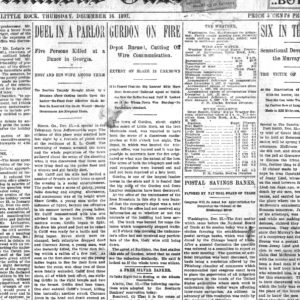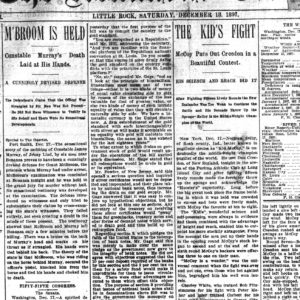calsfoundation@cals.org
James Murray (Murder of)
On December 6, 1897, the dead body of Constable James Murray was found by the roadside near Bonanza (Sebastian County). His hands were tied, and he had an injury to his head and bruises around his neck. Lying nearby was the unconscious body of Grant McBroom, whom he had earlier arrested. Both Murray and McBroom were white. The case attracted national attention, with newspapers such as the New York Times and the Los Angeles Herald speculating wildly and describing the murder as a “lynching” to showcase the apparent lawlessness of western Arkansas during this post-Reconstruction era.
Bonanza and nearby Jenny Lind (Sebastian County) are located south of Fort Smith (Sebastian County) and were centers for coal mining in the region. Bonanza enjoyed a strategic location on the main line of the St. Louis–San Francisco Railway, and although the town was not incorporated until 1898, the first mine had opened there in 1896. It was a company town, and the population peaked in 1900 at 906, thereafter declining as coal mining declined in the area.
The bare facts of the matter seem to be that Grant McBroom had been a miner in Jenny Lind, and he and a group of others had robbed Constable James Murray and a friend. Murray swore out a warrant against him, but McBroom disappeared (presumably to the nearby mines at Bonanza). Murray discovered McBroom’s new location, and, on December 5, he went to Bonanza to arrest McBroom. The arrest itself was uneventful, and Murray set off that night to Jenny Lind with his prisoner. This was the last time Murray was seen alive. The following morning, his body was found along the roadside not far from the Bonanza mine. His hands were tied behind his back, he had a head injury, and marks around his neck indicated that he had been choked to death. Nearby lay Grant McBroom, unconscious. Passersby raised the alarm, and friends of McBroom loaded him into a wagon and carried him away.
There were numerous explanations of this incident offered. Some of the officers who came to the scene thought that both men were drunk, and that McBroom had choked Murray to death and was then himself too drunk to escape. Others felt that the two had been waylaid by highwaymen, who were apparently common in the area, and that McBroom had been left for dead. Suspicion eventually settled on McBroom, however, and he was arrested that same day. He refused to speak about the crime, other than to maintain his innocence.
The story began to circulate in newspapers across the nation, and the accounts became more lurid. On December 9, the New York Times reported that Murray’s body looked as if it had been “roughly handled by a mob of lynchers. The head was almost severed, while the body was filled with bullets.” The coroner had supposedly concluded that McBroom was only pretending to be unconscious, and that Murray had been attacked by a mob of 300 of McBroom’s fellow miners. According to this account, the coroner ordered that all of the miners in Bonanza be arrested, to which the miners replied that he could come and get them—and that they had plenty of dynamite and would blow up the mine if any attempt was made to arrest them. The sheriff declared himself willing to do this but noted that the governor would probably be asked for help to assist local officials. The Los Angeles Herald reported that Murray’s bruised neck showed “plainly the imprint of a rope,” and that he had clearly been lynched and then cut down and placed by the roadside.
As McBroom’s preliminary trial approached, his defense began to stoke the rumors further. His lawyer maintained that the warrant for McBroom was part of a conspiracy to lure Murray out of Jenny Lind and, at the same time, place the blame for his subsequent death on McBroom.
According to this scenario, Murray was strangled four miles from Bonanza by a group of six men, and these murderers then carried his body back to Bonanza in a buggy. McBroom was not involved in the murder or the conspiracy, and would have died himself if he had not been discovered so soon. The defense claimed to have found the buggy and to know the identity of the people who had borrowed it.
The defense, however, came to trial with no witnesses and no corroborating evidence to support these claims. According to the Arkansas Gazette, “Testimony showed that McBroom and Murray left Bonanza only a few minutes before the killing.…The theory of the state is that McBroom, who was riding on the horse behind Murray, secured the officer’s pistol, knocked him from the horse and tied his hands and choked him to death.” McBroom was held without bail for Murray’s murder.
In March 1898, McBroom was granted a change of venue to Waldron (Scott County), and his trial was scheduled for the third day of the next circuit court term. He was eventually tried in August 1898 and acquitted.
McBroom may have gotten into more trouble later in his life, however. According to Fort Smith criminal case files, a Grant McBroom was to appear in court on counterfeiting charges on December 16, 1899. A few years later, on June 29, 1905, the White Oaks, New Mexico, Outlook reported that a Grant McBroom had been indicted for assault to kill with a deadly weapon but had forfeited his bond by disappearing.
For additional information:
“Arkansas Crime.” Los Angeles Herald, December 9, 1897, p. 2.
“Grant McBroom Murder Case.” Arkansas Gazette, March 24, 1898, p. 4.
“Killed His Captor.” Arkansas Gazette, December 9, 1897, p. 1.
“Lynchers Hide in a Mine.” New York Times, December 9, 1897, p. 5.
“M’Broom is Held.” Arkansas Gazette, December 18, 1897, p. 1.
“Six in the Gang.” Arkansas Gazette, December 16, 1897, p. 1.
Untitled. Arkansas Gazette, August 16, 1898, p. 4.
Nancy Snell Griffith
Clinton, South Carolina
 Law
Law Post-Reconstruction through the Gilded Age, 1875 through 1900
Post-Reconstruction through the Gilded Age, 1875 through 1900 James Murray Murder Article
James Murray Murder Article  James Murray Murder Article
James Murray Murder Article 




Comments
No comments on this entry yet.